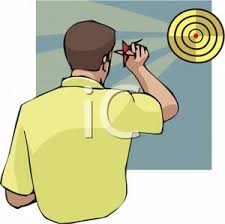Wall street hit or miss?
Standard 2 - Personal and financial goals can be achieved by applying economic concepts and principles to personal financial planning, budgeting, spending, saving, investing,borrowing, and insuring decisions.
Benchmark - 9.2.2.2.2 -Evaluate investment options using ctiteria such as risk, return, liquidity and time horizon; evaluate and apply risk management strategies in investing and insuring decisions.
Activity 2: A Random Walk Down Wall Street
"If you want to really strike it rich in the stock market, you should tape a list of stocks on the wall, throw darts at the list, and buy the stocks your darts hit."
Could this be true? Is it possible that choosing stocks at random could be just as effective as getting advice from financial experts and stockbrokers? If your object is simply to get rich buying stocks, the answer is quite possibly yes. If a dart board can deliver good results, does that mean the experts don't know what they're doing? No. The dart board can succeed because of the special nature of the stock market.
The stock market is one of the most competitive markets in the world. Millions of people are trying to identify the best stocks to buy every day, using sophisticated forecasting techniques. Public information about stocks is widely availabel to anyone who wants it, at a very low cost. Therefore, almost everything that can be known about a stock is known by large numbers of buyers and sellers and reflected in the market price of the stock. No one has an advantage over anyone else - unless they trade using private "inside information," which is illegal.
Economists use the term "random walk" to describe purchasing decisions in the markets just described. "Expert" forecasting in such markets isn't effective because everything known about past performance is already reflected in the stock price, and future prices will only be affected by unknown future events. In fact, even future events that are systematically predictable from past trends are reflected in the stock price, so only unexpected events will affect the future stock price.
If stock A and stock B are each selling for $20 per share, that is what the buyers and sellers in the market think the stock is worth. If there is unexpected good news about stock A and unexpected bad news about stock B, the price of stock A might rise to $30 while the price of stock B drops to $10. But which stock is the better buy then? Neither! After the prices change to reflect the new information, they will again both be selling for what the market thinks they are worth. Future changes in these prices will be the result of factors that are now unknown and unexpected.
The prices of most stocks rise over time, primarily because most companies reinvest a large part of their profits into their business, and when those investments succeed, there are higher future profits for the stockholders to share. But the prices of stocks tend to vary randomly around this long-term trend. A great deal of statistical research and a lot of practical experience by millions of people have generally shown this random-walk theory to be accurate. If you can find a way to show it is not true, allowing you to out-predict random choices of stocks, you can become very rich indeed.
Run a simple test of the random walk concept by selecting three stocks based on expert opinion and choosing three other stocks randomly. For expert picks, you might want to ask a stockbroker or check newspaper articles and weekly financial programs on PBS that recommend specific stocks. For random choices, you can use a dartboard that lists all stocks on the major stock exchanges or cut up company names on slips of paper and draw three from a hat.
In the table below, list stocks selected on the basis of expert opinion as numbers 1, 2, and 3. List randomly selected stocks as 4, 5, and 6. Then follow the stock prices and any dividend payment for several weeks. Calculate the return from investing $10,000 in each of the six stocks.
| Stock Company | Date Selected | Price | Subsequent Dates, Prices, & Dividends |
| 1. | |||
| 2. | |||
| 3. | |||
| 4. | |||
| 5. | |||
| 6. |
From Focus: High School Economics, © National Council on Economic Education, New York, NY